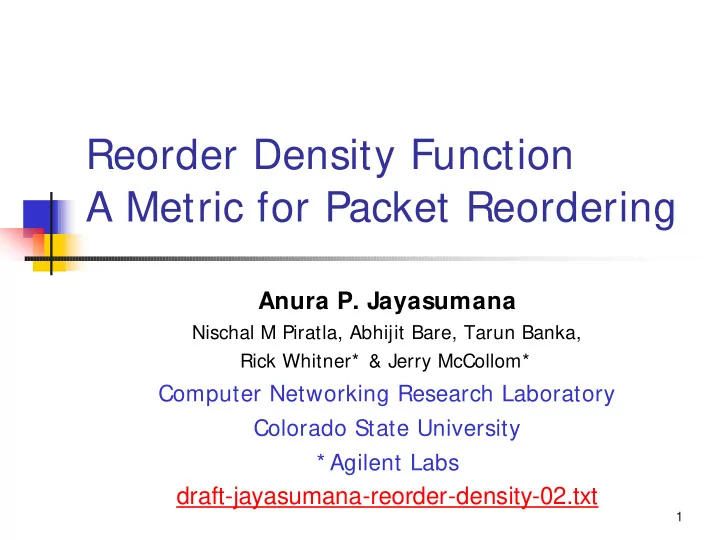

Reorder Density Function A Metric for Packet Reordering Anura P. Jayasumana Nischal M Piratla, Abhijit Bare, Tarun Banka, Rick Whitner* & Jerry McCollom* Computer Networking Research Laboratory Colorado State University * Agilent Labs draft-jayasumana-reorder-density-02.txt 1
Outline � RD Review � Properties � Improvements (LD, ED) � Discussion 2
Concept Reorder Density Com putation Module Incoming D T Sequence In-order Number Removal Occupancy If a packet with a sequence number higher than the currently expected � packet arrives, it is buffered. Packets are removed from the buffer, when they become in-order or � when the buffer is full. Occupancy of the buffer is recorded after each arrival is processed. � Size of the buffer (D T ) determines when a packet is considered lost or � useless. 3
Terminology Buffer Occupancy : Number of packets that arrived out-of-order � and are stored temporarily in a hypothetical buffer. Buffer Occupancy Threshold (D T ) : Maximum size of the � hypothetical buffer. Reorder Density (RD) : Density function of the buffer occupancy. � where F[i] is the number of arrival F[i] = instances where i buffers were occupied. RD[i] ∑ F[j] j 4
Examples of RD Computation Case of no packet loss : [1,2,4,5,3,7,6]. RD Computation Steps: Expected 1 2 3 3 3 6 6 Arrival 1 2 4 5 3 7 6 D 0 0 1 2 0 1 0 F[D] 1 2 1 1 3 2 4 Normalized Frequency RD: 0.7 0.6 Displacement (D) 0 1 2 3 0.5 0.4 Frequency F[D] 4 2 1 0 0.3 Normalized 4/7 2/7 1/7 0 0.2 Frequency RD[D] 0.1 0 0 1 2 3 4 Displacement 5
Examples of RD Computation Case of packet loss : [1,2,4,6,5,7,8] with D T =3. RD Computation Steps: Expected 1 2 3 3 3 3 8 Arrival 1 2 4 6 5 7 8 D 0 0 1 2 3 0 0 F[D] 1 2 1 1 1 3 4 Normalized Frequency 0.7 RD: 0.6 0.5 Displacement (D) 0 1 2 3 0.4 Frequency F[D] 4 1 1 1 0.3 Normalized 4/7 1/7 1/7 1/7 0.2 0.1 Frequency RD[D] 0 0 1 2 3 4 Displacement 6
Properties � On the fly computation � Computation Complexity � Time complexity : O(N.DT) < O(N 2 ) N no of packets � Space complexity : Constant (DT) � Shape of RD is related to the nature of reordering. � 90 th percentile, mean and standard deviation of RD can be used when a simpler metric is required 7
Properties � Captures both the number of packets that are out of order as well as the amount by which packets are out-of-order � A packet is considered lost if and only if the buffer overflows (DT) � Also useful for applications Ex. Resource allocation for recovery from reordering � Given a reorder density function, we can generate packet sequences that satisfies the reorder density function - Not just a measure! 8
Modifications � Late and Early Density: � Place Label (PL) – increments for each arrival (subject to DT) � Late Packet � Early Packet Example 1: Arrival: 1 3 4 2 5 PL: 1 2 3 4 5 Late - - - 2 - Early - 1 1 - - 9
Modifications Example 1: Arrival: 1 3 4 2 5 PL: 1 2 3 4 5 Late - - - 2 - Early - 1 1 - - Early/Late Density 0.6 0.4 0.2 1 0 1 2 Early-packets Late-packets 10
Modifications � Late and Early Density: � Place Label (PL) – increments for each arrival (subject to DT) Arrival: 1 3 4 5 6 7 PL: 1 2 3 4 5 6 11
Modifications � Late and Early Density: � Place Label (PL) – increments for each arrival (subject to DT) Ex: DT= 2 Arrival: 1 3 4 5 6 7 PL: 1 2 3 4 5 6 5 6 7 12
Modifications Example 2: (With DT = 2) 2 is treated 6 is ignored (duplicate as lost pkt.) Arr. 1 3 4 5 2 6 6 PL 1 2 3 4 -> 5 5 6 6 Late - - - - - - - Early - 1 1 0 - - - 13
Modifications Example 2: (With DT = 2) 2 is treated 6 is ignored (duplicate as lost pkt.) Arr. 1 3 4 5 2 6 6 PL 1 2 3 4 -> 5 5 6 6 Late - - - - - - - Early - 1 1 0 - - - 0.6 0.4 0.2 1 0 1 Early-packets Late-packets 14
Conclusion � RD, ED and LD more completely define reordering � Order of complexity is still the same � Extensions – Reordering to satisfy a given RD 15
Follow-up options ?? � Merge basic concept with Morton draft � Pursue as an alternate draft and/or as an informational RFC � Other ? 16
Recommend
More recommend